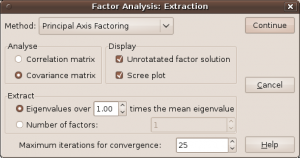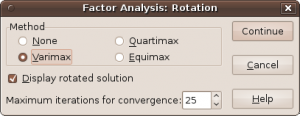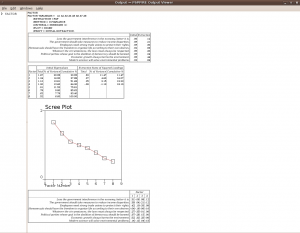Factor analysis and Principal component analysis
This page is a part of PSPP Guide.
Factor analysis is a procedure which tries to reduce the number of variables and detect structure in the relationships among observed variables. Factor analysis used to describe variability among observed variables in terms of fewer unobserved variables called factors. The observed variables are modelled as linear combinations of the factors, plus “error” terms.
Factor analysis is related to principal component analysis but not identical. Principal component analysis performs a variance-maximizing rotation of the variable space and it takes into account all variability in the variables. On the other side, factor analysis estimates how much of the variability is due to common factors (so called “communality”). The two methods become essentially equivalent if the error terms in the factor analysis model (the variability not explained by common factors, communality) can be assumed to all have the same variance.
Since SPSS places principal component analysis under factor analysis, PSPP also does so.
Factor analysis
To do factor analysis, go to Analyze – Factor Analysis.
You can select variables to include in factor analysis (in our case A1 to A8 from SJM 2002/2 data set; missing values recoded). Then click to Extraction… button and select Principal Axis Factoring as a method and other desired parameters. You can also mark that PSPP draws scree plot.
PSPP also computes factor rotation:
The results show that four eigenvalues are above 1 and 4 factors explain 18.1 % of the variance of variables A1 to A8. There are several criteria for determining the number of factors, for instance Kaiser criterion (which says all components with eigenvalues under 1.0 should be dropped), scree plot (when the curve in scree plot makes an elbow toward less steep decline, all further components after the one starting the elbow should be dropped, etc. Generally, factor model cannot be identifiable if it is over-factored (in that case factors can describe measurement errors); the number of factors should be less than (number of variables – 1) / 2.
Principal component analysis
To do principal component analysis, go to Analyze – Factor Analysis, select variables ans under Extraction… select Principal Component Analysis method.
Ključne besede: PSPP



